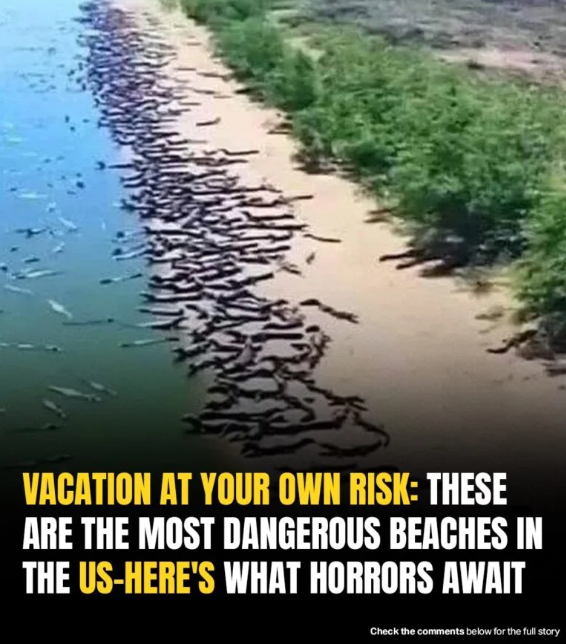Dreaming of a sun-soaked beach getaway? Before you pack your swimsuit and sunscreen, heed this warning: not all shores are safe. Researchers at Tideschart, a leading tide-forecasting platform, have scoured data from 528 U.S. beaches to reveal the 10 most dangerous coastal spots, all in Florida. From shark-infested waters to killer rip currents and hurricane havoc, these beaches are beautiful but deadly. Here’s the rundown on where to avoid—and how to stay safe if you dare visit.
Florida’s Fatal Shores: The Top 10 Riskiest Beaches
Tideschart’s study ranks beaches based on three hazards—shark attacks, surf zone fatalities, and hurricane exposure—scoring each out of 100, with higher scores signaling greater danger. Shockingly, Florida dominates the list, thanks to its volatile Atlantic and Gulf coasts.
-
New Smyrna Beach (Score: 76.92)
Dubbed the “Shark Bite Capital of the World,” this Volusia County hotspot, an hour northeast of Orlando, is a magnet for danger. With 277 recorded shark attacks—more than all other top 10 beaches combined—and 12 surf zone deaths from 2010 to 2024, it’s a swimmer’s nightmare. Its east coast location makes it a bullseye for hurricanes, with 126 storms battering the area historically. In September 2024, surfer Charley Hajek survived a bull shark bite here by using his surfboard leash as a tourniquet. -
Laguna Beach, Florida (Score: 67.75)
Not to be confused with California’s Laguna, this Panama City Beach in the Panhandle claims the grim record for surf zone fatalities—39 since 2010, driven by ferocious rip currents and towering waves. Nine shark attacks add to the peril. Its Gulf Coast perch doesn’t spare it from hurricanes, with storms like 2024’s Hurricane Milton amplifying risks. -
Daytona Beach (Score: 64.47)
Just north of New Smyrna, Daytona’s bustling boardwalk and car-friendly sands draw 10 million visitors annually—but its waters are lethal. Powerful currents have caused 27 surf zone deaths, and 67 shark attacks have been logged. Rip currents are so notorious that in 2023, three people were swept out, with one fatality. Beach driving and water sports add chaos, making vigilance crucial. -
Miami Beach (Score: 46.49)
Famous for nightlife, this South Florida gem hides a dark side. Thirteen surf-related deaths and 17 shark attacks mark its shores, worsened by strong currents and hurricane vulnerability (126 storms on record). Crowds and alcohol-fueled incidents heighten risks, and a 2024 boardwalk shooting underscored human-related dangers. -
Indialantic Boardwalk (Score: 44.64)
This tiny Brevard County boardwalk may be quaint, but its 8-foot swells and unpredictable currents are fierce, causing nine surf zone deaths and 30 shark attacks. Popular with surfers, it lacks lifeguard coverage in some areas, making it a hidden hazard. -
Cocoa Beach (Score: 44.01)
Home to surf legend Kelly Slater, Cocoa Beach blends charm with danger. Thirty-nine shark attacks and seven surf fatalities, plus occasional debris from nearby Cape Canaveral launches, keep swimmers on edge. Crowds and frequent thunderstorms add unpredictability. In 2023, it ranked high for shark incidents, with a 7.57/10 attack rate. -
Palm Beach (Score: 43.53)
Known for luxury and Mar-a-Lago, Palm Beach faces strong undercurrents, 35 shark attacks, and seven surf deaths. Jellyfish stings spike in summer, and its 126 hurricanes amplify risks. Hurricane Milton in 2024 battered its shores, leaving debris hazards. -
Miramar Heights Beach (Score: 41.88)
Unique on this list, this Gulf Coast beach has zero recorded shark attacks but 10 surf fatalities, thanks to hidden drop-offs and rip currents. Its soft sands belie the danger, making it a deceptively risky spot. -
Cape Canaveral (Score: 40.75)
Famous for rocket launches, this beach draws crowds unaware of its strong currents and occasional space debris washing ashore. Seven surf deaths and a history of hurricanes (126) make it perilous, despite only a few shark incidents. -
Jupiter Beach Park (Score: 40.37)
Rounding out the list, this scenic park hides dangers like unguarded areas, 23 shark attacks, and five surf fatalities. Its natural beauty and wildlife, including sharks, demand caution, especially during the 126 hurricanes that have struck.
Why Florida’s Beaches Are So Deadly
Florida’s monopoly on danger stems from its geography and climate. The state’s 1,350 miles of coastline face the Atlantic’s wrath and Gulf’s warmth, fueling hurricanes from June to November, peaking August to October. These storms churn up rip currents—narrow, high-speed channels that drag swimmers out to sea—and storm surges that reshape shores. In 2024, Hurricanes Helene and Milton alone caused $25 billion in coastal damage, per NOAA.
Shark attacks, while rare (your odds are 1 in 11.5 million, per ISAF), are concentrated in Florida, which logged 16 unprovoked bites in 2023, 44% of the U.S. total. New Smyrna’s proximity to Ponce Inlet, a fish-rich zone, lures sharks close to shore. Surf zone fatalities, often from rip currents, claimed over 90 lives nationwide in 2023, with Florida’s Laguna, Daytona, and Miami leading the toll.
How to Stay Safe
Don’t ditch your beach plans, but arm yourself with knowledge. Tideschart’s Ryan Blundell warns, “Hurricanes cause powerful rip currents and storm surges, which significantly elevate the risk for beachgoers.” Here’s how to navigate Florida’s treacherous shores:
-
Swim Smart: Always choose lifeguarded beaches. In 2024, Volusia County lifeguards performed 3,200 rescues, mostly from rip currents. If caught in one, swim parallel to shore until you escape, then angle back.
-
Avoid Sharky Hours: Skip dawn and dusk swims when sharks hunt. Don’t wear shiny jewelry, which mimics fish scales, and swim in groups.
-
Heed Warnings: Obey red or double-red flags signaling high surf or rip currents. Check NOAA’s rip current forecasts and local weather alerts, especially during hurricane season.
-
Stay Sober: Alcohol fuels risky behavior. Miami Beach’s nightlife proximity led to 20% of its 2024 water incidents being alcohol-related, per Consumer Gravity.
-
Know Your Beach: Research conditions. For example, Cape Canaveral’s rocket debris risks are unique, while Indialantic’s unguarded zones catch novices off guard.
A Silver Lining: New York’s Safe Haven
While Florida’s beaches dominate the danger list, New York boasts a gem. Coopers Beach in Southampton, crowned a top U.S. beach by Dr. Stephen Leatherman (“Dr. Beach”), dazzles with white quartz sand and grass-covered dunes. Its calmer waters and lower shark activity (only 4 attacks in Suffolk County since 1837) make it a safer bet. “It’s a big, beautiful beach,” Leatherman told CNN.
The Bottom Line
Florida’s beaches are a paradise with a perilous edge. New Smyrna’s shark-infested waves, Laguna’s deadly currents, and Daytona’s chaotic shores demand respect. “Most people don’t realize how much changing surf conditions, unpredictable marine life, and severe weather can impact their safety,” Blundell says. Before diving in, check Tideschart’s data, swim near lifeguards, and stay alert. The ocean’s beauty is worth enjoying—just don’t turn your back on it.

